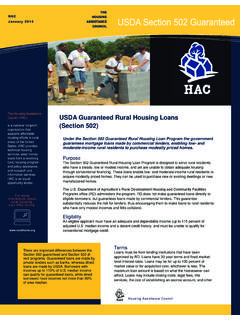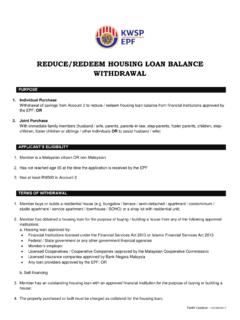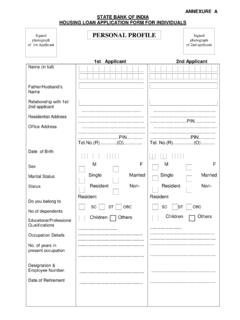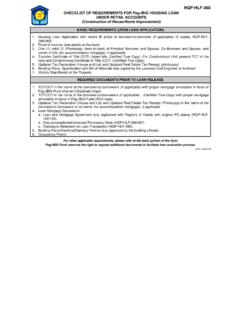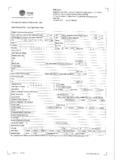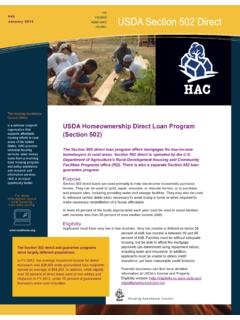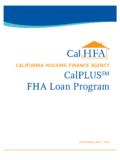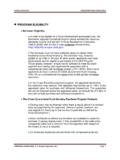Transcription of FHA’s Single Family Housing Loan Quality Assessment ...
1 FHA Office of Single Family Housing June 15, 2015 FHA s Single Family Housing loan Quality Assessment Methodology (Defect Taxonomy) June 18, 2015 1 FHA s Single Family Housing loan Quality Assessment Methodology, June 18, 2015 1 FHA manages a variety of risks in operating its Single Family insurance Programs. FHA is committed to achieving the appropriate balance between managing these risks and achieving FHA s mission to meet the Housing needs of its targeted population. To that end, FHA has further refined its risk management processes. Background Risk Management Tools* Performing and Early Payment Default Reviews ( loan -Level) Lender Self Report Reviews ( loan -Level) Claim Reviews ( loan -Level) Lender Monitoring Reviews (Lender) Compare Ratio / Credit Watch & Lender Insurance Monitoring (Lender) Lender Annual Recertification (Lender)
2 Consequences* Feedback to / discussion with lender Corrective action by lender Indemnification request / demand Increase in loans sampled Suspension or Withdrawal of LI privileges Referral to Mortgagee Review Board Monetary Penalties Indemnification Probation / Suspension / Withdrawal of FHA approval / Letter of reprimand Referral to OIG * Lists are not necessarily exhaustive 2 FHA s Single Family Housing loan Quality Assessment Methodology, June 18, 2015 2 Purpose: Managing Compliance Risk As noted previously, FHA has a wide variety of resources and tools available to manage compliance risk and will exercise discretion in determining the appropriate use of those resources and tools. This Taxonomy is not a universal statement on all compliance monitoring or enforcement efforts by FHA or the Federal Government and does not establish standards for administrative or civil enforcement action, which are set forth in separate law.
3 The Taxonomy does not address FHA s response to patterns and practice of loan -level defects, regardless of severity, or FHA s plans to address fraud or misrepresentation in connection with any FHA-insured loan . What is the Quality Assurance Defect Taxonomy? What is it not? This Taxonomy is FHA s plan to increase the efficacy of its own Quality Assurance efforts. The Taxonomy addresses FHA s plans to identify and capture information about defects and severities revealed through an individual loan -level review. 3 FHA s Single Family Housing loan Quality Assessment Methodology, June 18, 2015 3 This Taxonomy represents an evolution in FHA s approach to Quality Assurance. Pre-Taxonomy Approach to QA Taxonomy Two potential levels of findings for each defect - Unacceptable and Deficient,1 providing only a limited ability to analyze the scope of defects solely on the basis of the finding reported.
4 Subdivision of each existing findings level, creating four tiers of defects, allowing FHA to capture greater detail on the scope of the defect. Much of the detail of the sources and causes of defects is captured only in loan reviewer s notes, which prevents data analysis on why defects are occurring at the aggregate level. The sources and causes of defects are captured as part of the Basis of Ratings code, allowing FHA to analyze the reason why defects are occurring at the aggregate level. The majority of current defect codes focus on causes, often leading to multiple codes all describing a small piece of a Single fundamental issue ( , borrower income not being sufficient). The coding of defects is standardized within a limited number of defect categories, allowing FHA to capture greater detail on the fundamental issues impacting a loan s Quality .
5 Although there are significantly fewer defects, each defect employs between 15-30 reason codes to capture rich detail about why a defect occurred. 1 The terms Unacceptable and Deficient refer solely to the code names used by FHA in its previous QA systems and practice and should not be extrapolated to any other context or for any other purpose. Because these terms could be open to a variety of interpretations and do not provide the level of specificity desired by FHA, they are being replaced under the Taxonomy with Tier labels. 4 FHA s Single Family Housing loan Quality Assessment Methodology, June 18, 2015 4 The methodology centers on three core concepts Identifying a defect There are nine fundamental characteristics of loan insurability that impact a loan s insurability, credit Quality , and compliance.
6 Each of these fundamental characteristics has one defect associated with it, for a total of nine defects. I Assessing the severity of a defect Severity is assigned to the individual instance of the defect, not to each individual source and cause. Severity is driven by the size and nature of the deviation from FHA s requirements and the impact to loan insurability. Allows FHA insight into defects in its portfolio while maintaining the ability to isolate those defects for which Lenders are not responsible ( , for defects about which they did not and could not have known). III Capturing the sources and causes of the defect A defect may be composed of one or many sources and causes found in the loan or in the input of loan file data into TOTAL.
7 Potential sources and causes of a defect vary by defect type. II 5 FHA s Single Family Housing loan Quality Assessment Methodology, June 18, 2015 5 There are nine defect categories Defect (Code) Representative examples Primary drivers of severity Under-writing Valuation process Eligibility Operations Borrower Income (BI) DTI ratio and/or inability to calculate DTI due to income error Income not supported by provided documentation Borrower employment history not satisfied Front end / back end DTI (because of income) 1 Borrower credit / liabilities (BC) Credit report provided is not acceptable Borrower does not have an established payment history Missing/misstated liabilities Back end DTI (due to debt) and derogatory credit issues 2 loan to value and max mortgage amount (LM) LTV/CLTV is over the statutory or program limit Mortgage amount exceeds statutory or location based limit HECM principal limit exceeded LTV / CLTV / max mortgage 3 Property eligibility (PE Structural soundness of the property is in question Necessary repairs not completed or documented Qualitative issues of eligibility 5 Borrower eligibility and qualification (BE) Borrower identity or residency status cannot be verified Borrower does not appear to meet occupancy requirements Borrower is delinquent on a federal debt Qualitative issues of eligibility 7 Lender operations (LO))
8 loan originator permitted misuse of escrow funds Lender/ loan Officer/Sponsored Third Party Originator is not registered in NMLS Qualitative issues of compliance 9 Mortgage eligibility (ME) Forward Mortgages: loan does not meet FHA/program eligibility requirements Impermissible restrictive covenants on property or in contract loan delinquent before lender submitted loan for endorsement HECM Mortgages: Eligibility requirements not satisfied/acceptably documented Qualitative issues of eligibility Qualitative issues of eligibility 8 4 Borrower Assets (BA) Assets to cover MRI and closing costs Minimum required investment not met Gifts from unacceptable sources or the transfer not appropriately documented I 6 Property appraisal (PA) Value not supported Where required, second appraisal is missing 6 FHA s Single Family Housing loan Quality Assessment Methodology, June 18, 2015 6 Each defect has several identifiable Source and Causes Defect (Code) Source of Defect Examples Cause of Defect Examples Borrower Income (BI)
9 Standard Employment Part-time/Seasonal Employment Overtime, Bonus, or Commission Income Amount not supported by documentation Stability not supported 1 Borrower credit / liabilities (BC) Insufficient or unverified data or information Incorrect conclusions drawn 2 loan to value and max mortgage amount (LM) Amounts cannot be confirmed Identity of Interest issues 3 Property eligibility (PE 5 Borrower eligibility and qualification (BE) Eligibility/qualification not supported by documentation Misrepresentation/Fraud 7 Lender operations (LO) Violation of FHA Policy Misrepresentation/Fraud 9 Mortgage eligibility (ME) Eligibility/qualification not supported by documentation Misrepresentation/Fraud 8 4 Borrower Assets (BA) Amount not supported by documentation Gifts not documented II 6 Property appraisal (PA))
10 Pension / Retirement Income Self-Employment Credit Report does not meet requirements or missing Issues calculating borrower debt Payment history not established Derogatory credit information does not support approval Maximum Mortgage Amount LTV CLTV HECM Principal Limit or Maximum Claim Amount Minimum required investment not met Closing Costs or Cash Reserves not met Minimum Property Requirements and General Acceptability Criteria Condo project not approved Repairs not completed or repair escrow not established New Construction ineligible Appraisal valuation not supported Appraisal missing or expired Appraisal report does not meet FHA standards Issues with Borrower or non-borrowing spouse s identity Borrower credit score CAIVRS, LDP/GSA and/or court-ordered judgment issues and/or delinquent Federal debt issues NMLS registration information incorrect or missing Issues with Late Endorsement Certification AUS Feedback Certificate missing Misuse of escrow URLA FNMA 1003 and/or HUD-92900-A is missing or not properly executed Mortgage delinquent at endorsement loan does not meet mortgage product eligibility criteria Conditions of title to property not acceptable Determinations not supported FHA policy applied incorrectly Determinations not supported FHA policy applied incorrectly Note.










